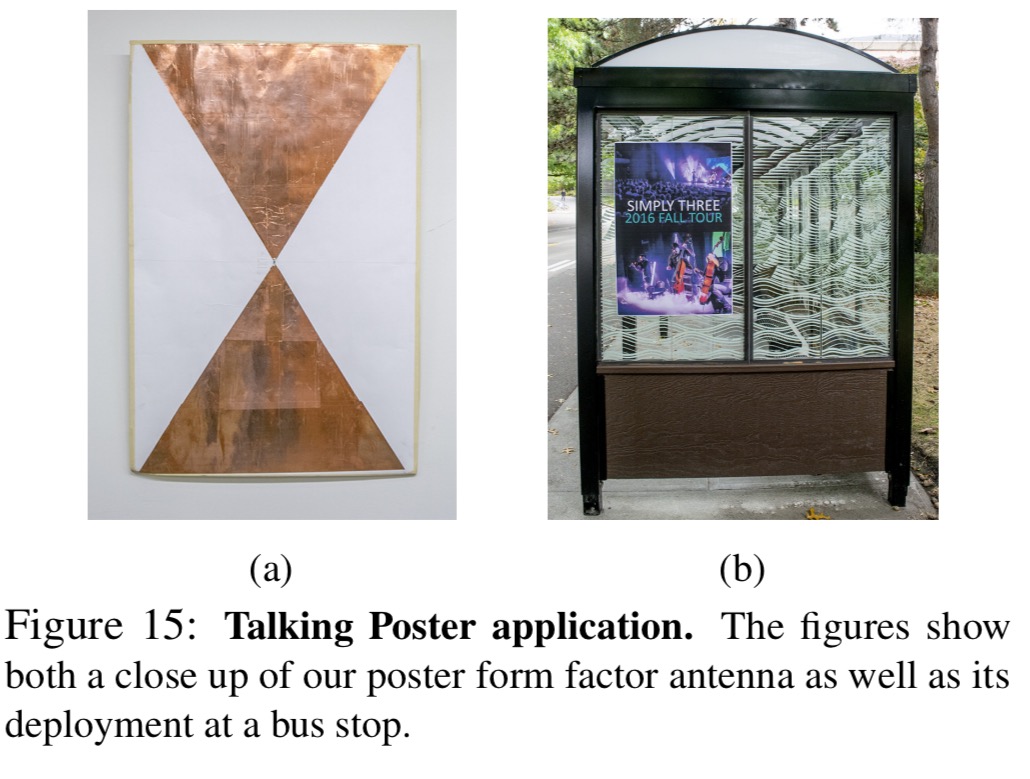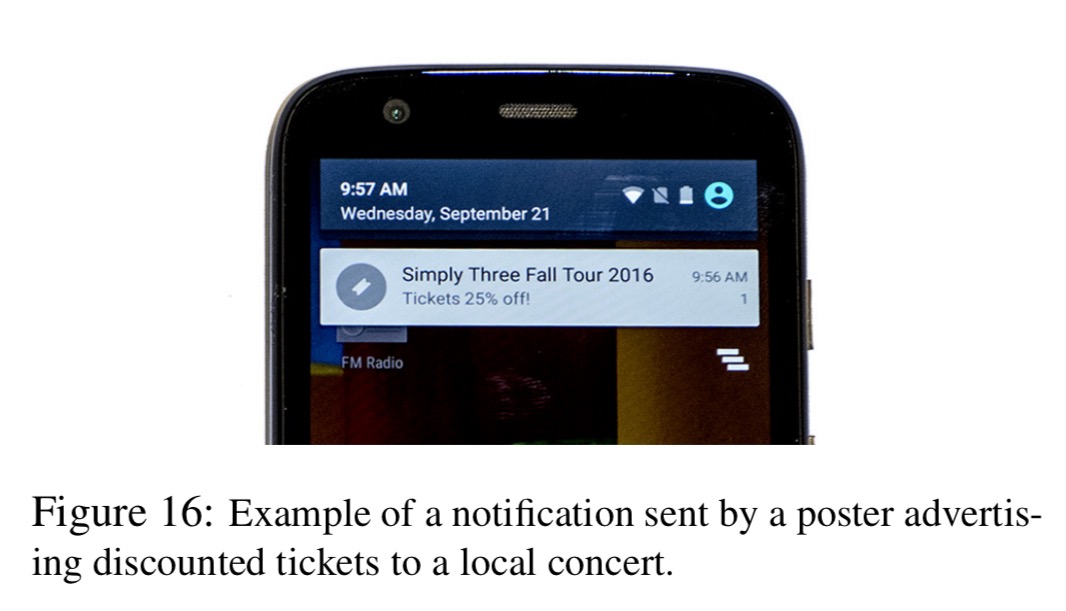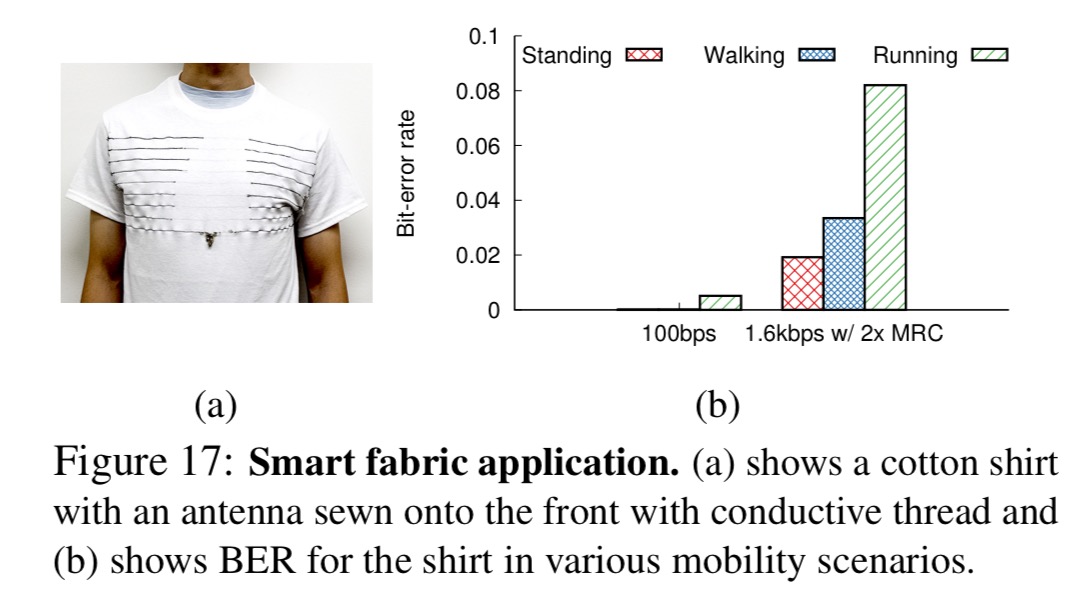FM Backscatter: Enabling connected cities and smart fabrics Wang et al., NSDI’17
If we want to connect all the things, then we need a means of sending and/or receiving information at each thing. These transmissions require power, and no-one wants to have to plug in chargers or keep swapping batteries for endless everyday objects. So where will this power come from? One promising approach uses ambient backscattering. Ambient backscatter devices pick up existing transmissions (e.g., TV or Wi-Fi signals) and convert them to tiny amounts of electricity, this power is then used to modify and reflect the signal with encoded data.
This paper enables connectivity on everyday objects by transforming them into FM radio stations. To do this, we show for the first time that ambient FM radio signals can be used as a signal source for backscatter communication.
It turns out that, for example, all those talk show radio programmes really are a powerful medium. In the literal sense.
The prototype system built by the authors achieved data rates of up to 3.2 kbps, and ranges of 5-60 feet, while consuming as little as 11.07 μW of power.
Requirements for communicating everyday objects
The goal is to enable communication from everyday objects in outdoor scenarios (for example, from bus stop posters, street signs, smart clothing, and so on) to smart phones and cars. Wide outdoor deployment of RFID readers would be expensive, Wi-Fi backscatter is only really useful indoors, and TV signal receivers are not included in smartphones and most cars.
What about Bluetooth Low Energy (BLE)? In broadcast mode, BLE can send short packets every 100ms, and therefore won’t work for streaming audio. In addition, the bluetooth antenna in cars is positioned inside to interact with mobile phones and other devices. The car body itself would shield such an antenna from any outside signals.
What we really want is a solution that:
- Uses ambient signals that are already ubiquitous in outdoor environments
- Can be easily received by cars and smartphones using existing hardware
- Is legal to backscatter in the desired frequencies without a license (which rules out cellular transmissions)
- Enables decoding of the raw incoming signal without any additional hardware.
The suitability of FM radio
Enter FM radio!
- Broadcast FM radio infrastructure exists in cities around the world
- FM radio towers transmit at high power (several hundred kilowatts), providing an ambient signal source suitable for backscattering
- FM radio receivers are included in the LTE and Wi-Fi chipsets of almost every smartphone (and of course, are in cars)
- In the US, low-power transmitters can operate on FM bans without requiring a license
- FM radios provide access to the raw audio decoded by the receiver, which can be used to extract the backscattered data
c_ in one of these FM bands, and information at each time instant is encoded by a deviation from _fc_.
### Backscattering FM radio
The authors describe three mechanisms for backscattering FM radio transmissions: overlay backscatter, stereo backscatter, and cooperative backscatter.
Backscattering is a multiplicative operation in the frequency domain. Say a signal source is transmitting a tone signal at a centre frequency
. For a backscatter signal with baseband
, we need to generate the signal
.
If we pick such that it is centred at
and uses audio signal
then an FM radio tuned to the frequency
will output the audio signal
.
Thus, by picking the appropriate backscatter signal we can use the multiplicative nature of backscatter in the RF domain to produce an additive operation in the received audio signals. We call this overlay backscatter because the backscattered information is overlaid on top of existing signals and has the same structure as the underlying data.
is chosen so that
lies at the centre of an unoccupied FM channel. There are plenty such channels available, as the following indicates:

To send audio (e.g., a music sample for a band advertised on a poster) the desired audio can be overlaid directly. To send data, audio signals are generated using modulation techniques. The desired cosine signals are approximated with a square wave alternating between +1 and -1.
These two discrete values can be created on the backscatter device by modulating the radar cross-section of an antenna to either reflect or absorb the ambient signal at the backscatter device. By changing the frequency of the resulting square wave, we can approximate a cosine signal with the desired time-varying frequencies.
If an FM radio station is broadcasting in mono, then audio or data can be backscattered in the stereo stream without interference from the audio signals in the ambient FM transmissions. To tell the receiver to pick up the stereo stream, the backscattering device also needs to generate the 19 kHz pilot signal. This is the stereo backscatter approach. There’s a variation that works well for talk shows too:
While many FM stations transmit in the stereo mode, i.e. with the 19 kHz pilot tone, in the case of news and talk radio stations, the energy in the stereo stream is often low. This is because the same human speech signal is played on both the left and right speakers… based on this observation, we can backscatter data/audio in the stereo stream with significantly less interference from the underlying FM signals.
Cooperative backscattering can give much lower error rates, but requires the cooperation of two receiving devices to create a MIMO system. One device is tuned to the original band of the FM signal ($f_c$) and the other is tuned to . The joint information can be used to cancel the ambient FM signal and decode the backscattered signal. See section 3.3 in the paper for further details.
Data encoding
Data is encoded using frequency-shift keying (FSK). Two schemes are described, a low rate scheme (100 bps) for low signal-to-noise ratio (SNR) environments, and a higher rate (1.6 or 3.2 kbps) scheme for high SNR environments.
For the 100 bps transmission, a binary FSK scheme (2-FSK) is used where zero and one bits are represented by the frequencies 8 and 12 kHz respectively. For high bit rates, a combination of 4-FSK and frequency division multiplexing is used: sixteen frequencies between 800 Hz and 12.8 kHz are grouped into four consecutive sets, within each set 4-FSK is used to transmit two bits. Experiments showed that the bit-error rate (BER) performance degraded significantly above 3.2 kbps, so this is the maximum achievable rate for the target applications.
Implementation and evaluation
The FM backscatter design is implemented in an integrated circuit with a TSMC 65 nm LP CMOS process (see section 4 of the paper for detail). A Moto G1 smartphone with Sennheiser MM30i headphones as its antenna is used for smartphone receiving, and a 2010 Honda CRV is used for car testing.
For the smartphone, the following plot shows how SNR changes as a function of the distance between the backscatter device and the FM receiver at five different power levels. At a -50 dBm power level, the power in the backscattered signal is still reasonably high at close distances.

At 100 bps, the BER is nearly zero at distances up to 6 feet across all power levels, and for power levels greater than -60 dBm range increases to over 12 feet. At 1.6 and 3.2 kbps range is reduced, but BERs are still low up to 3 and 6 feet away at -60 and -50 dBm respectively.
For the car receiver, the system can work well up to about 60 ft.

We leverage the low power backscatter techniques described in this paper to show that posters can broadcast information directly to cars and smartphones in outdoor environments. To evaluate this, we design two poster form factor antennas…

The results showed that data could be decoded at 100 bps at distances of up to ten feet with a smartphone. An overlaid snipped of music from the band advertised on the poster could be decoded at a distance of up to 4ft. The car could detect the same signal at 10 ft.

The team also designed a smart shirt by machine sowing an antenna into it:

We perform this experiment in an outdoor environment in which the prototype antenna receives ambient radio signals at a level of -35 dBm to -40 dbm. Fig. 17b (above) compares the bit error rate when the user is standing still, running (2.2 m/s) or walking (1 m/s). The plot shows that at a bit rate of 1.6 kbps while using MRC, the BER was roughly 0.02 while standing and increases with motion. However at a lower bit rate of 100 bps, the BER was less than 0.005 even when the user was running. This demonstrates that FM radio backscatter can be used for smart fabric applications